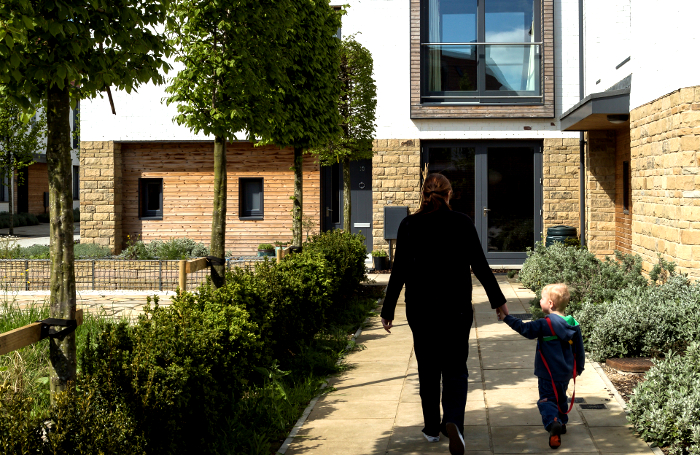Do building occupants care what the exterior of their building looks like? The answer, according to several housing developers, might well be 'not much, if at all'.
“Most individuals who are not design-led do not look up, in the way architects do,” suggests Hanna Afolabi, development specialist and Managing Director of Mood and Space. “The ground floor is where their experience is.”
She is not talking about domestic clients commissioning their own private houses here. Afolabi has worked on large regeneration projects throughout her career. She was previously Development Director at Balfour Beatty, where she was responsible for achieving planning permission for over 1500 homes in two new neighbourhoods at the Queen Elizabeth Olympic Park in East London.
Understanding what the community wants, drives value for the developer. If an architect is pitching to a large housing developer client, particularly one with social value commitments, they would do well to keep their feet on the ground, so to speak.
Put design in context
Designers do talk about the layout, she acknowledges. But she wants to hear about people's user experiences as they move through the space. Focus on how people will live in and utilise it.
“Designers do have a tendency to overanalyse and overexplain how, say, windows line up or the features of a brick,” Afolabi continues. “They sometimes forget the experience factor: contextualising how people operate day to day.”
“Check yourself: are you only looking at the big picture? Scale down to the human experience. How would it feel to be walking through here? How would it feel at night? Do certain corners create risks for antisocial behaviour? Would this feel welcoming and safe?”
Appreciate that the experiences of different genders and different ages may be very different. 3D modelling and VR are useful tools in this regard, she finds. Anything that prompts the designer to interrogate the experience of walking through a space can be very instructive.

Remember: you are not pitching to architects
The trap to avoid is that of pitching – or indeed designing – as if it were to fellow architects, Afolabi advises and she is by no means alone in this conviction. One highly experienced housing client, who wished to remain anonymous, puts it very bluntly.
“Very few residents care what their building looks like,” he states. “This is upsetting, but it is true. That does not absolve architects of the responsibility to make the most attractive possible building and landscape of course - we all experience buildings.”
He has experienced numerous practices bidding for social housing work and in interview situations that struggle to place themselves in the shoes of the resident. A common error is that there is not enough reference to either the client’s priorities or the end user’s.
“Most social housing clients are risk-averse, process-oriented, financially aware and very focused on residents,” he continues.
“But all too often, architects will insist on talking architecture to them at the most inappropriate moments. You rapidly end up hearing about what timber they used on the side of a building, and that’s not really what you want to know.”
He admits that developing an on-the-ground understanding of the resident’s experience is not easy. Post Occupancy Evaluation (POE) is one way forward. Clients have to allow architects into estates and people’s homes to conduct POE. This could be as simple as a chat about the layout and materials. He acknowledges that POE often faces challenges, with clients reluctant to pay for this process.
Speak the same language
“The construction industry as a whole doesn’t really speak a language that is people-centric,” Afolabi believes.
She points out some common culprits: “units” instead of “homes” and “tenants” instead of “residents”. And she encourages architects to articulate projects as if they were at a public consultation.
“If you are trying to draw people into a project, you need to strip down the vocabulary: make it easily understood.”
Use inclusive images
Afolabi is critical of many CGIs of projects. They are not, she finds, reflective of the communities that they are supposedly serving. They often do not include people of colour, or people with disabilities.
While they might include a mother with a pushchair, or an older couple, they often do not include a broad age range. Teenagers are frequently noticeable by their absence.
“This is another way where we fail to humanise the process,” she feels. “You end up excluding a whole range of people without realising. And these are the images that the community will see.”
A challenge and an opportunity
Afolabi is at pains to stress that she is not singling out architects here: she believes that the industry as a whole needs to humanise its communication across the board.
There are opportunities to be had by becoming more socially aware and understanding what the developer wants, especially for regeneration projects.
“As an industry we need to remember our mission is to develop change and improve experiences, whether it is people’s living spaces, offices or parks.”
Thanks to Hanna Afolabi, Managing Director and Founder, Mood and Space.
Text by Neal Morris. This is a Professional Feature edited by the RIBA Practice team. Send us your feedback and ideas.
RIBA Core Curriculum topic: Business, clients and services.
As part of the flexible RIBA CPD programme, professional features count as microlearning. See further information on the updated RIBA CPD core curriculum and on fulfilling your CPD requirements as a RIBA Chartered Member.









